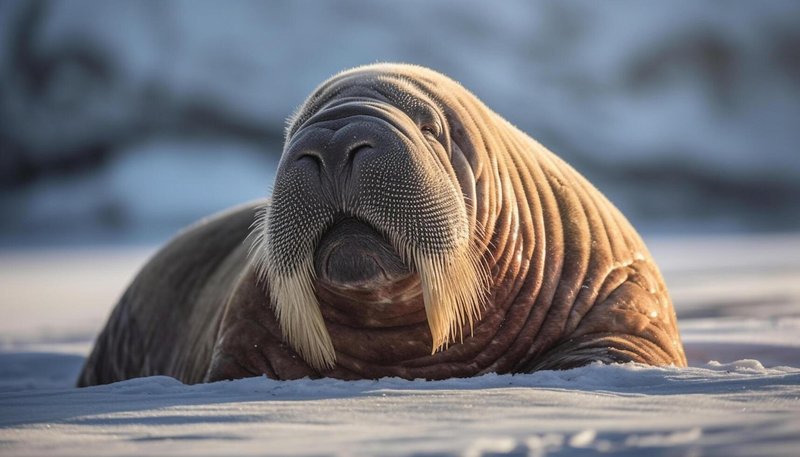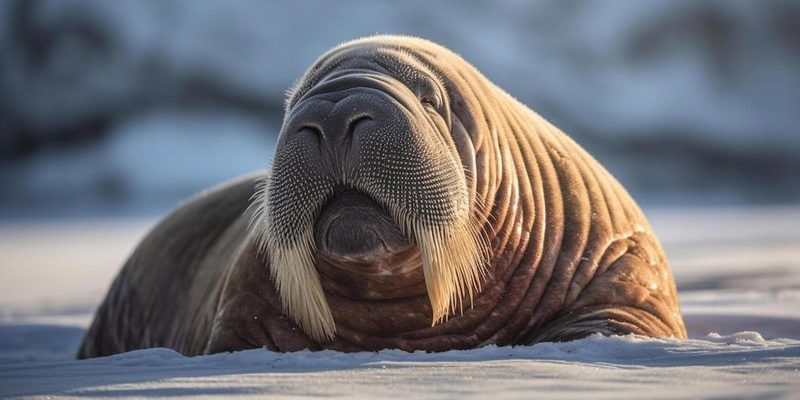
Now, before diving deeper, let’s picture a walrus like a comfy couch potato, lounging around and chatting with friends. Their communication skills might not include gossip about the latest trends, but they have their own stories to tell. From vocalizations to physical gestures, walruses navigate their world and maintain social bonds in ways that are both practical and impressive. So, grab your favorite coffee, and let’s explore how these fascinating creatures stay connected and find their way!
The Physical World of Walruses
Walruses primarily live in the Arctic and sub-Arctic regions, floating through the frigid waters of the Northern Hemisphere. They often rely on ice platforms, which serve as resting spots, breeding areas, and places to haul out. This icy environment is both a playground and a challenge, as walruses must navigate through shifting ice and freezing waters filled with threats.
These marine mammals are equipped with unique adaptations that help them thrive in such extreme conditions. Their blubber, which can be up to several inches thick, keeps them warm in icy waters. Moreover, their whiskers, or vibrissae, are highly sensitive, allowing them to detect movement and even taste the ocean floor as they hunt for clams, their favorite snack. Navigating isn’t just about swimming; it’s about understanding this complex environment and using their senses to find food and avoid predators.
How Walruses Navigate Underwater
You might be wondering how walruses can move so gracefully in icy waters. Well, their massive flippers and streamlined bodies give them the ability to glide effortlessly. They can dive deep, often reaching depths of 300 feet or more in search of food. But how do they know where to go?
Walruses utilize a combination of visual cues and sonar-like abilities to navigate. They have excellent eyesight both above and below water, which helps them spot prey and obstacles. Additionally, they seem to use the sound of clicks and grunts to communicate with each other, but these sounds also help them gauge their surroundings. Just like when you walk through a dark room and use your ears to guide you, walruses listen for echoes to find their way.
Another fascinating aspect is their ability to rely on memory. Studies show that walruses can remember locations of food sources and resting spots, much like how you remember your favorite coffee shop in a busy city. This memory plays a vital role in their daily navigation.
Communication Through Vocalizations
When it comes to communication, walruses are vocal champions. They produce a variety of sounds including barks, whistles, and clicks. Each sound serves a purpose, from simple greetings among friends to warning calls when a predator is near.
Imagine you’re in a crowded room trying to find your friend. You might call out their name or make a distinct noise to get their attention. Walruses do something similar—they use specific vocalizations to signal each other. For example, a low growl might mean “I’m feeling threatened,” while a series of high-pitched whistles could indicate excitement or play.
Interestingly, walruses also communicate through physical gestures. They use their tusks, flippers, and body movements to assert dominance, show affection, or even establish social hierarchies within their groups, or herds. It’s a silent but effective way to convey emotions and intentions.
Social Structures and Group Dynamics
Walruses are social creatures, often found in large groups that can number in the thousands. This social structure plays a crucial role in their navigation and communication. In a herd, walruses often rely on group dynamics to stay safe and find food.
When foraging, walruses will often dive together, helping each other locate schools of clams. In this way, teamwork is essential—much like friends working together to tackle a group project. If one walrus finds a good spot to eat, it can signal to others, ensuring that everyone has a chance to feast.
This social interaction also extends to when they haul out on ice. Being part of a group helps them protect against predators like orcas and polar bears. The more eyes watching out for danger, the safer everyone feels.
Non-Verbal Communication
Besides vocal sounds, walruses have a rich repertoire of non-verbal communication methods. Their large tusks are not just for display; they play a significant role in social interactions. These tusks can be used for physical displays, such as pushing or shoving, which helps establish dominance or show submission.
Additionally, body language is vital in walrus communication. For instance, a walrus that keeps its body low to the ground may be showing submission or discomfort, while a walrus that stands tall and bold with its tusks displayed is demonstrating confidence and readiness to assert itself.
It’s fascinating to think about how much can be communicated without saying a single word. In the walrus world, actions speak louder than sounds, making their communication multi-dimensional.
The Importance of Communication in Survival
For walruses, effective communication is essential for survival. Their vocalizations and physical interactions help maintain social bonds, coordinate group movements, and stay aware of potential dangers. In a harsh environment, being able to convey information quickly can make the difference between life and death.
Moreover, the ability to navigate efficiently ensures they can find food and suitable resting spots. As ice conditions change due to climate change, walruses have to adapt their strategies for navigating their environment. This adaptability underscores how crucial communication is to their survival. Just like how you would adapt your plans with friends based on the weather, walruses adjust their behaviors based on environmental conditions.
It’s a reminder that every creature, no matter how large or small, has a role in its ecosystem and that communication is a vital part of that role.
The walrus is a remarkable example of how animals navigate and communicate in their environment. These large, social mammals rely on a mix of vocalizations, body language, and group dynamics to thrive in the challenging Arctic. Through their unique adaptations, they’ve developed impressive skills that allow them to find food, stay safe, and maintain relationships within their herds.
As we continue to learn more about walruses, let’s appreciate how their methods of navigation and communication reflect their resilience and adaptability. So next time you see a walrus, remember that it’s not just lounging about; it’s a master of its icy domain, skillfully navigating its world and chatting with its friends.

